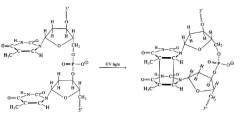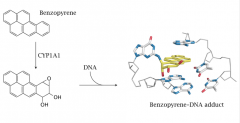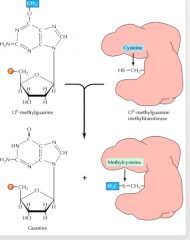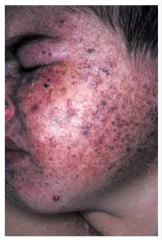![]()
![]()
![]()
Use LEFT and RIGHT arrow keys to navigate between flashcards;
Use UP and DOWN arrow keys to flip the card;
H to show hint;
A reads text to speech;
37 Cards in this Set
- Front
- Back
|
What nucleic acids pair with which? |
Guanine - cytosine adenine - thymine |
|
|
What is a silent mutation? |
no effect on cell - occurs in DNA sequence with no function (junk DNA) - mutation doesn't alter function of sequence (in coding region but doesn't change amino acid sequence, or changes on not affecting protein's function) |
|
|
What mutations alter function of a protein or RNA? |
- changes amino acid critical for enzymatic activity of a protein - alteration in protein that functions to control cell division - change splicing of mRNA, or translation reading frame |
|
|
What causes mutations? |
1. DNA replication errors - DNA polymerase incorporates wrong nucleotide 2. Various agents (mutagens) |
|
|
How do chemical agents act as mutagens? |
Act by reacting with chemical groups of base involved in specific base-pairing, causing wrong nucleotide to incorporate others act by pertubing DNA structure, leading to increased probability of nucleotide incorporation during replication |
|
|
What are examples of chemical agents? |
- deaminating agents acting on cytosine, adenine or guanine (e.g.: nitrous acid from nitrates and nitrites in bacon) - base analogs incorporated into DNA - alkylating agents: add alkyl groups to base to block correct base-pairing (N-methyl-N-nitrosurea: mustard gas) - intercalating agents: ethidium bromide - slide between stacked bases and distort double helix causing replication errors. Benzopyrene in cigarette smoke |
|
|
What are examples of radiation damage mutagens? |
x-rays gamma rays UV light |
|
|
What are ways radiation damage acts as mutagens? |
- DNA strand breakage: chromosome can split into pieces - lead to large chromosomal deletions - UV light causes dimerization of adjacent thymine bases: thymine dimers inhibit DNA replication (prolonged exposure to sunlight - cancer) |
|
|
What are deamination reactions? |
changes one base into another - altered bases prefer to base-pair with "wrong" partner base - naturally-occuring modified DNA bases like 5-methylcytosine can also be deaminated |
|
|
What are UV-induced thymine dimers? |
distort DNA structure and make it difficult for DNA polymerase to replicate DNA regions containing them |
|
|
What are intercalating agents? |
flat planar structures that perturb DNA structure by inserting between stacked bases-promotes replication errors |
|
|
What happens when benzopyrene gets inside cells? |
Benzopyrene turns into CYP1A1 CYP1A1 interacts with DNA to create benzopyrene-DNA adduct |
|
|
What are the three types of DNA repair mechanisms? |
- direct repair - excision repair - mismatch repair |
|
|
What does direct repair do? |
repairs thymine dimers and alkylated bases - scan DNA and looks for lesions - finds damage and repairs without cleaving or removing the base |
|
|
How does excision repair work? |
- recognize and replace damaged DNA - repairs thymine dimers and deaminated bases 1. recognize damage - endonuclease cuts backbone 2. exonuclease removes damaged DNA segment 3. DNA polymerase fills in the gap and ligase seals |
|
|
How does mismatch repair work? |
direct repair and excision repair function - looks for bases not normally found in DNA - recognizes normal bases that are incorrectly base paired 1. Replication fork passes - mismatch repair enzymes scan new DNA and replace incorrect bases with correct one 2. use original parental strand as template for repair DNA synthesis |
|
|
What is an example of direct DNA repair? |
alkyltransferase removes methyl groups from DNA bases (O6 methylguanine to guanine) |
|
|
What is the excision repair pathway? |
1. Damaged DNA strand marked for repair by action of repair enzymes and break in phosphodiester backbone 2. affected strand removed by helicase or exonuclease 3. gap filled by DNA polymerase and sealed by DNA ligase |
|
|
What is an example of excision repair? |
repair of damage resulting from deamination of cytosine by uracil N-glycosylase (UNG) |
|
|
How does excision repair work by UNG? |
1. UNG recognizes U/G mispairs and hydrolyzes N-glycosidic bond of deaminated cytosine 2. resulting apurinic (AP) site recognized by second repair enzyme that removes deoxyribose by cleaving sugar-phosphate backbone on both sides of lesion 3. gap filled in by DNA polymerase and phosphodiester bond by ligase |
|
|
How does mismatch repair work? |
repairs mismatches in DNA that has just been replicated by using original parental strand as template for replacement |
|
|
How does mismatch repair know to use the parental strand? |
distinguishes between old and new because original parental DNA is methylated (Dam methylase) for a short time after replication while newly synthesized isn't |
|
|
What is an example of E.coli mismatch repair? |
E.coli key proteins in mismatch repair - MutS, MutL, MutH |
|
|
What is an example where DNA changes are not equally repaired? |
cytosine and 5-methyl cytosine - both can be deaminated deamination products not repaired with same efficiency gives different propensities to cause mutations |
|
|
What is xeroderma pigmentosum caused by? |
mutations in excision-repair genes - extensive freckling - photosensitivity - cataracts - frequent skin tumors |
|
|
What do XP patients have a decrease in age onset of? |
skin cancers |
|
|
What failed DNA repair mechanism leads to hereditary non-polyposis colon cancer (HNPCC) |
- 80% risk for colon cancer - mutations in mismatch repair proteins MLH1 (mutL ortholog) and MSH2 (MutS ortholog) - more likely to have strand slippage in short nucleotide repeats - lead to cancer |
|
|
What does lack of mismatch repair lead to in HNPCC? |
- microsatellite instability - instability - changes in length of nucleotide repeat sequences between cells - can promote cancer if in or near proto-oncogenes or tumor suppressor genes |
|
|
What is fanconi anemia? |
- growth retardation and abnormal development - stem cell failure - 1000x risk of cancer - fused chromosomes after exposure to DNA cross-linking agents |
|
|
Why is there a large variety of severity/penetrance in FA patients? |
- group of proteins work together as a complex (fanconi anemia complex) - not every protein in complex is equally important; loss of some subunits more deleterious than others - same for XP and Cockayne syndrome |
|
|
What are interventions for patients with DNA repair diseases? |
1. reduce exposure of patient to mutagens such as UV light, nitrates, etc. 2. gene therapy to deliver normal copies of mutant genes to cells in patients body (SCID example) |
|

|
deamination |
|

|
UV-induced thymine dimers |
|

|
intercalating agents: benzopyrene in cigarette smoke |
|

|
alkyltransferase reaction removing methyl groups in direct DNA repair |
|

|
xeroderma pigmentosum |
|
|
What is the pathway for gene therapy (severe combined immunodeficiency (SCID)) as example |
- virus with necessary gene comes into cell - gene inserted into chromosome - cell begins to make protein from gene - leads to normal phenotype |

